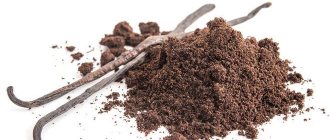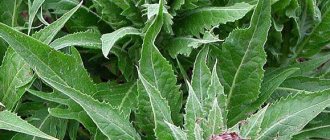Chemical composition
Thuja is widely used in folk medicine, as well as in pharmaceuticals, homeopathy, and cosmetology. Its value is determined by its composition. Thuja contains:
- vitamin C;
- glycosides;
- flavonoids;
- tannins;
- saponins;
- thuic acid;
- aromadendren;
- resins;
- pentoxifylline;
- tannin;
- sesquiterpene alcohol.
In addition, thuja produces phytoncides in large quantities. These substances destroy harmful microorganisms.
Indications for use
Preparations and remedies with thuja help cope with many diseases. Among them:
- ARVI, acute respiratory infections, colds;
- pneumonia;
- cystitis;
- swelling;
- dental diseases;
- gynecological diseases;
- disruption of the genitourinary system;
- disturbances in the functioning of the gastrointestinal tract;
- allergy;
- depression, constant stress;
- apathy, sudden mood swings;
- problems with potency, frigidity;
- enlarged adenoids;
- inflammatory processes of various nature;
- bleeding, etc.
What is used in folk medicine
In total, there are 2 varieties of thuja - western and eastern. Both types of wood are considered medicinal and have similar properties. Oriental arborvitae mostly grow in China. They can be recognized by their bluish bumps.
In our country, western thujas with greenish-yellow cones are ubiquitous. It is believed that the highest concentration of beneficial substances is contained in the cones, but in folk medicine, needles, branches, and shoots of the tree are often used. Oils, decoctions, and tinctures are prepared from them.
Thuja. Beneficial features
Essential oil is obtained from the leaves of thuja occidentalis, which is used in medicine and is part of disinfectants. Also, thuja oil is added to various cosmetics, such as shampoos, balms, body and hair creams.
Alcohol tincture from thuja needles to remove calluses
An alcohol tincture of thuja needles is used to remove warts, papillomas, polyps, and calluses.
Recipe:
A tincture with pharmaceutical Vaseline in a concentration of 1:1 helps to get rid of calluses and corns very effectively. To do this, mix the tincture prepared according to the recipe above with pharmaceutical Vaseline in equal parts. Apply to the calluses and secure with a bandage. Several treatments can remove the most stubborn and painful calluses and corns.
Also, thuja oil is used in medicines in homeopathy.
Source
Use in folk medicine
Thuja is excellent for auxiliary therapy. The use of products with thuja should definitely be discussed with a doctor, as they have contraindications and uncontrolled use can cause severe harm to health.
Next, we will present you with recipes for preparing medicinal products, as well as the recommended dosage for taking them. Don’t forget to discuss this with your doctor, because each case is individual.
Thuja tincture
This is an almost universal remedy that helps against various ailments. The tincture is prepared simply:
- collect fresh pine needles and thuja cones, wash, finely chop;
- 3 tbsp. l. place the resulting raw materials in a ceramic bowl;
- fill the needles with medical alcohol (200 ml);
- Cover the dish with a lid and place in a dark place;
- infusion time - 2 weeks, do not forget to shake the contents;
- then strain.
If medical alcohol is not on hand, you can use vodka instead. However, in this case, per 100 ml of vodka you will have to take 1 tbsp. l. crushed raw materials.
How to use:
- Internally. Add 10-15 drops of tincture to 50 ml of water, take before meals 3 times a day. Course – 2-4 weeks. After which you should take a two-week break and, if necessary, repeat the course. It is used for severe coughs, upper respiratory tract diseases, asthma, chronic liver diseases, sexually transmitted diseases, etc.
- Externally. Apply the tincture to the problem area of the skin 2 times a day. The course is until recovery. It removes enlarged pores, small papillomas, acne and warts well. In addition, it helps with rheumatism, mild frostbite, gum inflammation, etc.
Thuja decoction
The decoction is considered a good expectorant, anti-inflammatory and wound healing agent. For cooking, you can take any part of the tree or put everything together.
The standard decoction recipe looks like this:
- Peel and chop the pine needles and thuja cones;
- put 2 tbsp. l. raw materials in a thermos;
- pour hot water, but not boiling water (500 ml);
- leave for 1 hour;
- filter.
How to use:
- Internally. 2 tbsp. l. decoction 2-3 times a day after meals. Course - 2 weeks. The course is repeated again, but after a week's rest. Helps against arthrosis, arthritis, dry cough, ailments of the genitourinary system, nervous disorders, etc.
- Externally. To use the prepared thuja infusion should be diluted with water in a 1:1 ratio. This product is suitable for washing and douching. Apply 2 times a day. Course – 1 week. Helps with inflammation of the pelvic organs and gynecological diseases.
Thuja oil
It is impossible to obtain such oil on your own. It is extracted through distillation in industrial production conditions. This takes quite a long time.
There are 3 types of thuja oil:
- Essential. This is a powerful healing agent that is suitable only for spot application. For example, in order to remove acne, papillomas, old calluses.
- Homeopathic. Prescribed for diseases of the respiratory system, adenoids, skin lesions, etc.
- Aroma oil. It has a calming effect, perfectly relieves fatigue and improves concentration. Can be added to aroma lamps and baths.
Before using any thuja oil, be sure to read the instructions for use. Exceeding dosage limits leads to side effects such as headache and vomiting.
Green cones appeared on the thuja. Are there any bumps on your thujas? Why can and should they be collected?
Arborvitae rightfully occupy a central place in many suburban areas. High frost resistance and variety of thuja varieties make these shrubs indispensable in landscape compositions and for creating evergreen hedges. Young dense thuja bushes are especially loved by gardeners, but in mature plants at the age of about 10 years, the crown often looks sparse and diseased. In many cases, the cause is the ripening of thuja fruits - small cones. From a distance, such thujas appear to be covered with dried shoots and growths.
Anyone who is at least a little familiar with the principles of constructing garden compositions or is simply fascinated by the beauty and grandeur of coniferous plants will probably give the palm to various types and varieties of thuja. This is just a lifesaver for a garden designer. It’s absolutely impossible to do without it in the landscape business, because it is a vertical accent in the garden, an element of year-round decorativeness, and a fertile material for hedges...
Yes, these plants are beautiful, beyond competition. Almost ideal, until at a certain period they become covered with small brown bumps. Is this good or bad? Some people really don’t like the fruits because from a distance they resemble dried out, diseased shoot tips or brown growths. What to do in this case, how to save beauty?
Is it really possible to go up to each specimen of this plant with a bucket and pruning shears and cut, cut, cut until they are all cleaned up? Of course, you can do just this if there are only two or three thujas on the site and they are young and quite short. Perhaps this is the best option for such a case. But no one has canceled the laws of nature.
Thuja cones are valued in folk medicine: they are used to make ointments and tinctures that fight many diseases
Cones are seeds; next year they will appear on the plant again. In a year, your thujas will become taller, and it will be harder to jump with pruning shears and a bucket, cutting off the excess.
There is an opinion that thuja produces a lot of cones after a dry summer. Thus, a stressed plant thinks that it is in danger of completely drying out and tries to compensate for this by reproducing. Water your plants more deeply during dry periods.
Recent Entries
How to properly plant and grow grapes in central Russia How and with what to process currants after wintering and during the season Monterey - remontant garden strawberries from California
If you plant thujas in a row by regularly trimming them, you can not only rid them of cones, but also form a dense hedge of a given height.
When forming plants, a number of conditions must be observed.
- Deadlines. Conifers are pruned in the spring before new shoots emerge. In this case, it is advisable to cut last year’s crops by no more than one third. Then you can prune again in late June - early July. The more regularly haircuts are carried out, the more noticeable the result will be. This means that if you trim the plant this year, do not forget to do so next year.
- Use high-quality, well-sharpened garden tools. Small plants can be trimmed with pruning shears in the second or third year after planting. Then you can no longer do without garden shears. Good gardening tools, in my opinion, are produced by the Japanese company ARS.
- Feeding. Don’t forget to feed plants weakened by haircuts. In principle, thujas tolerate crown formation by trimming well. But this event is still stressful to a certain extent. Therefore, do not forget to regularly feed your thujas with special fertilizers for conifers (they can be purchased at any gardening store) and anti-stress drugs, such as Epin-extra or Zircon. Give preference to mineral ones. More magnesium, less nitrogen. From organic sources, vermicompost or rotted compost are suitable. Fertilize in early spring after the snow melts and again in summer. It is better to complete them by August, so as not to provoke the growth of new shoots that will not have time to ripen by winter.
Thuja occidentalis Smaragd (description) is a monoecious evergreen plant with a dense and narrow pyramidal crown with bright green needles. The tree is an ornamental plant, which means it belongs in a natural or artificial landscape. A hedge made of thuja Smaragd looks royal, and it’s up to you whether to make it slender and uniform or to allow each tree to grow in its own way, preserving its originality.
Features and characteristics of thuja western Smaragd will help you get to know this amazing plant better:
- The height of an adult thuja Smaragd plant usually varies in the range from 4 to 6 m, and the untreated width is up to 2 meters.
- Average life expectancy is 110-130 years. If we talk about how quickly Thuja Smaragd grows, then on average, per year the tree grows no more than 20 cm in length and 4-5 cm in width.
- Thuja occidentalis Smaragd is one of the most popular representatives of the cypress family.
- The tree has the shape of an oblong cone with a pronounced crown and a thick coniferous covering. It is very malleable, which is why landscape designers love to give it different sculptural forms.
- Thuja Smaragd is an evergreen plant, which means it will remain so even in winter and after a hundred years.
- In spring, thuja blooms with small oblong brown cones, which fall off with the onset of autumn cold weather.
- Thuja feels great even in the cold Russian winters, since it has enviable frost resistance.
- The tree grows on any Russian soil and requires minimal care.
- Thuja grows not only in gardens and vegetable gardens, but also within the city. A polluted environment does not have any negative impact on the ripening of this tree.
- Thuja western Smaragd actively releases phytoncides, especially during its flowering period, due to which it purifies the air and saturates it with useful substances.
- The plant looks equally impressive in the form of a single planting and in a hedge environment.
- Thuja Smaragd occidentalis is most often divided into 2 main subspecies: thuja with a green color and thuja with a golden color.
Recent Entries
Planting grapes in autumn as an alternative to spring: what are the benefits? Technology for pruning cherries in autumn: diagrams and instructions for beginners Beautiful maple tree in landscape design: 60 photos of successful application ideas
Thuja is one of the excellent ornamental and useful plants for your garden or plot.
It has the property of disinfecting the air and releasing phytoncides, which improves immunity.
There are five types of thuja: Western, Korean, Sichuan, folded and Japanese.
It can be either a low-growing shrub or a tree up to 15 meters in height.
This evergreen plant makes a great addition to any landscape all year round. Coniferous trees or shrubs take root well in different regions. Most species are frost-resistant specimens.
They often tolerate frosts down to -30 degrees. The plant grows well in cities with polluted air. In different climatic zones, except for the far north and very frosty areas.
The most popular is the western thuja; it is most resistant to frost.
Thuja is a non-capricious plant. It is not difficult to care for her. It is undemanding to soil and moisture and tolerates decorative pruning well. Loves light, but not constant sun. Therefore, it is best to plant it in partial shade.
During the first time after planting, the plant will require care; subsequent growth and health depend on this.
• Young seedlings require regular watering in the evening or in the morning (1, 2 times every 10 days depending on weather conditions) and spraying - sprinkling once a week).
We invite you to familiarize yourself with Photinia: varieties and types of red-leaved shrubs for hedges
• Mulching. The root circle is covered with sawdust, spruce branches, and peat. This will prevent the soil from drying out. In summer, mulching protects the plant from the sun and in winter from freezing.
• Loosening around the seedling is necessary for good growth and development. But this is done to a depth of no more than 10 cm, since its roots are in the surface layer.
• In winter, the crown of the thuja is tied to avoid branches breaking under the weight of snow.
• Feed the tree once a year. If the first time is when planting, then the next one will be in a year or two. It is good to add the growth regulator Epin (1 ampoule per 10 liters) when planting.
• severe frosts: some plant varieties are not very frost-resistant and may freeze,
• drought,
• sun – can burn young plants, so partial shade is better for planting,
If it seems to you that the thuja has dried up, then you need to know that every 3-6 years in the fall, the scales of its needles tend to die off, but new ones grow in the spring. In this case, you just need to clean off the dead scales.
• insufficient watering, the plant needs to be watered regularly, but not overwatered: after planting - once a week, and in dry weather - 2 times a week, in an amount of about 10 liters per tree,
• overdose of chemical fertilizers or preparations; the plant should be fed two years after planting at the rate of 100 g per m2 of mineral fertilizers, and 2-3 liters of organic fertilizers. It is not recommended to use fresh manure; you can use rotted manure for six months, leave the slurry for at least 10 days and pour it under the plant, diluting it with water.
• the presence of rodents in the soil: moles, mole crickets, and a nearby anthill.
Thuja, in addition, may be subject to some diseases and pest invasions. As a result, it can dry out and disappear.
These are diseases such as late blight, brown shoots, rust and schutte. Among the dangerous pests are: thuja false scale, thuja moth, wireworm, thuja pine beetle, spider mite.
Late blight
This is a fungal disease dangerous for all plants, which affects first the root, then the top part. It looks like this: the tree withers, then the leaves appear gray in color, the trunk softens from below. The root begins to emit a putrid odor. It is usually difficult to cure plants affected by late blight, but you can try.
Collection and preparation
Thuja is a fairly unpretentious plant that can grow anywhere. It can often be found in city parks and near roads. Collect raw materials only from trees that grow in environmentally friendly places.
Important! Cones, shoots, and needles from thuja should be harvested at the end of May or early summer. At this time, the concentration of nutrients in them is maximum.
Next, the raw materials should be properly dried. Place everything in a thin layer in a well-ventilated area out of the sun.
The dried product can be stored in paper boxes or glass jars. Shelf life - 1 year.
Thuja occidentalis Brabant: planting, care and cultivation in open ground video
Beauty requires effort - it starts with regular watering, especially the first month after planting - overdrying is unacceptable.
Thuja grows well only in fertile and moist soil. Plants growing in a flowerpot or container cannot tolerate drying out at all. It is more difficult to track the loss of moisture in conifers than in deciduous ones - the leaves of conifers hang down like rags, while those of conifers turn yellow and dry out. Therefore, watering in open ground should be regular, when there is no rain, approximately once a week.
It is believed that thujas take watering very well by sprinkling, the water washes away dust from the crown and increases air humidity, but thujas love moist air and naturally grow along the banks and slopes of rivers and reservoirs.
However, during sprinkling, you need to make sure that the water not only drips onto the crown, but also wets the root layer under the trees. If there are signs of a fungal infection on the thuja, try to avoid sprinkling during treatment and carry out regular watering from a watering can.
There are varieties that are completely intolerant of both dryness and low air humidity, for example, Globoza nana (miniature spherical), these are best planted near a garden pond, fountain, or stream.
After planting, thuya has enough nutrients for several years; as a rule, feeding is not needed for the first two years.
In the future, you can improve the soil structure and fertile soil layer by adding a 7-10 cm layer of compost under the trees, rake off the top layer of soil and replace it with humus, and mulch the top with chopped pine bark.
Some varieties, for example, Columna, are sensitive to compaction of the soil surface, the roots do not have enough oxygen, the plants wither, these necessarily require annual loosening and renewal of mulch.
If there is no cow or horse humus, you can replace it with leaf humus.
As fertilizing, it is advisable to use mainly phosphorus-potassium fertilizers, preferably complex with a set of other minerals, designed specifically for coniferous plants. Usually two feedings per season at the beginning and end of summer are sufficient.
Do not forget that the application of mineral fertilizers reduces the pH, and excessive dosages can burn the roots, which is manifested in the browning of the needles, usually not immediately, but within a month.
Crown inspection
Thuja occidentalis is an evergreen plant, but the renewal of leaves and twigs occurs regularly, as a rule, “leaf fall” occurs in the fall, and since the crown of many varieties is very dense, the process can occur unnoticed by us.
Therefore, do not forget to look inside the crown, move apart the branches and select yellow needles; sometimes they accumulate between the branches near the trunk, collecting in “tangles”.
Trimming
Typically, thujas respond well to pruning, do not get sick, and only become thicker after cutting.
If a variety has a columnar shape, this does not mean that the plant will grow branches with a strict pyramidal geometry; some varieties, such as Smaragd, have a clear outline of the shape, others, such as Brabant, grow shaggy and need constant pruning to form a well-groomed appearance.
In young plants just purchased from a nursery, it is often necessary to reduce the number of leading branches, otherwise the plant grows into two or three trunks (double-vertical) and all decorativeness is lost. If possible, select in advance specimens of columnar thujas with one leader trunk. If there are several of them, leave one, carefully trim the second. The crown will grow over the season.
We invite you to read How to delay menopause and enjoy life: five ways to stop being afraid of menopause
Trimming the tips of the shoots should be done in the spring, with the opening of the buds and until mid-summer, some varieties, especially fast-growing, spherical or ovoid, need to be pruned twice a season, others, slow-growing ones less often - once in the spring, then the crown grows a little over the summer, and the plants look more natural. You can shorten branches by 1/3 of the length maximum, or less if necessary.
Almost all varieties of western thuja need protection from snow and ice. Their branches grow vertically upward, the snow that has accumulated and frozen into the ice cap presses on them and breaks them out. Therefore, you need to tie the trunks so that the snow flies off without stopping.
The binding should be done with soft material - nylon tights are simply ideal for this role - they do not rot and stretch. You can’t tie the crown too tightly, like Christmas trees before being piled into the truck, otherwise the needles inside will rot.
Small specimens, no more than 1.5 m tall, are best protected not with a harness, but with a hut. Make a tripod from wooden slats and wrap it in burlap or white lutrasil.
It is important to consider the susceptibility of some varieties to sunburn. There are varieties that are very resistant - the same Smaragd, occasionally the tops of the heads can burn, and there are varieties that require shelter for the most dangerous period - from the end of February to April in the form of burlap or a protective screen.
Sometimes thujas do not burn in the sun for only one reason - they are heavily covered with snow, this applies mainly to young plants and low-growing spherical ones, but if the winter turns out to be little snow, they are at risk of sunburn, so focus on the weather and precipitation.
The picturesque evergreen tree is loved by designers and cottage owners because of its unique decorative qualities. Elongated coniferous thuja pyramids form beautiful “living” hedges that hide the territory of individual plots from prying eyes. The plantings emit a delicate aroma all year round, and in winter they turn the area into an enchanting fairy tale.
Thuja is responsive to care. The crown is easy to cut and give the desired shape, which the slender beauty retains for a long time.
Peculiarities
The homeland of thuja is North America and East Asia. Despite its exotic origin, it has excellent winter-hardy qualities, unpretentiousness, and good survival rate. The only “contraindication” to cultivation will be arid areas or regions with winter temperatures below – 30-36°C.
Brabant branches of a lush green hue
Characteristics:
- Compact branched crown of conical shape;
- with scaly needles with a strong aroma;
- rich green color of the crown, sometimes with a golden-yellow veil at the ends of the branches. The peculiarity of the Brabant variety is that it retains its rich color, unlike other types of thuja, all year round.
- rough brown bark with exfoliating structure;
- rapid growth: over the course of a year, thuja occidentalis can increase up to 30-40 cm in height, and in diameter - up to 12-15 cm.
Brabant is the tallest representative of the thuja family, reaching a maximum height of 20 m with a crown 4 meters in diameter. True, in the conditions of central Russia you can rarely find coniferous representatives taller than 5-6 m. Some record holders reach 10-15 m. The flowering period of the tree is April-May: oblong brown cones up to 10 mm in size appear on the thuja.
Points to consider before boarding:
- Brabant is not picky about the type of soil, but dry, nutrient-poor soil will lead to poor crown formation and inexpressive color.
- Thuja loves sunlit areas, but direct sunlight leads to dehydration of the plant. It is optimal to give preference to partial shade.
- Brabant has a closed root system, which allows replanting without harming the health of the tree.
- All planting measures are effective in spring.
Planting a thuja seedling
The root hole for planting is prepared according to the size of the root system: approximately 1 meter wide. On wet soil, loamy soils, drainage of 15-20 cm (expanded clay, broken brick) is first poured.
A mixture of turf, peat, sand in a ratio of 2-1-1 is laid on top. Pre-planting fertilizing with nitroammophos at the rate of 300-500 g per tree will accelerate the development of the root system. After filling the hole, the root collar should be level with the ground.
The landscaping is completed with abundant watering. The water should “stand” in the depression near the trunk.
Landing geometry
- Hedge: the recommended planting frequency will be 0.5-0.7 m between trees;
- Thuja alley: the row spacing is maintained at a width of 6-9 m, the distance between seedlings is 3-4 meters in a row.
- The depth of the roots, depending on the height of the seedlings, is 0.6-0.8 m. Thuja alley Thuja hedge
Rules of care
Two weeks after planting, the cuttings are watered abundantly. So that the soil around the future tree is well moistened.
You will also need:
- Watering during the dry period (2 times every 7 days) with spraying.
- The first winter is a big test for the young Brabant: the adaptation process is not yet completely completed. Therefore, covering the crown with kraft paper or other material is required. The method protects the tree from cold, sunburn and winter-spring sun.
- To improve root nutrition and enrich the soil layer with oxygen, the soil is regularly loosened (no deeper than 0.1 m) and mulched with peat additives.
- Regular prevention with fungicides against diseases and insect pests that are relevant to thuja.
You should not hope for a sharp increase in size in the first year of planting. This is a period of rooting, adaptation to soil and climatic conditions. You can make the establishment easier by fertilizing the young shoots. However, when adding growth accelerators to the planting soil, you should not overuse feeding with such compounds during growth. An excess of nutrient chemicals inhibits the formation of the crown and the color appearance of the needles.
Reproduction
Shaft with heel
There are practice-tested methods for propagating thuja occidentalis:
- Cuttings with a heel. They are collected from a young bush in the spring before awakening or when buds begin to set.
- Cuttings obtained by pruning thuja occidentalis reproduce well. For rooting, it is enough to place shoots 10-12 cm long in a jar of water. After a year, such roots are ready for planting in the ground.
- Summer cuttings of the first stage of growth. True, complete rooting cannot be achieved over the summer: it will require wintering in a well-lit, cool room.
- By dividing young bushes, which are spudded in the spring and divided at the beginning of autumn.
- Horizontal bends followed by rooting within 12 months. True, this method is fraught with disruption of crown formation, which worsens decorative characteristics.
Trimming
Trimming the western thuja in compliance with the basic requirements allows you to implement very interesting design options.
Basic recommendations:
- The first full pruning is carried out 2-3 years after planting.
- Thuja withstands the haircut procedure. But you need to select a powerful pruner to avoid deformation of the cutting areas. This way, the planned crown configuration is formed faster and the structure of the branches is not damaged.
- If there is an idea to acquire a green wall, a two-stage pruning will be required during the summer season. The first pruning takes place in early summer after budding and formation of branches. Then leveling is carried out at the end of August. This method provides good compaction of coniferous mass for hedges or decorative forms. To maintain the configuration between haircuts, it is necessary to periodically carry out corrections: cut off the side shoots and the top of the crown.
- Formation begins only after Brabant has reached the planned height. It is not recommended to cut off more than a third of the shoot, otherwise the bush weakens and the crown becomes sparse.
Diseases
- Thuja false scale fungal infections. It appears as brown shoots in early spring. Diseased branches should be removed immediately, otherwise the infection will eventually affect the entire plant. The best way to combat fungus is prevention. To do this, limestone is dug into the roots or the thuja is sprayed with a 2% solution of foundationazole every 14 days from May to early October.
- False scale insect (Phomopsis). The disease manifests itself as yellow and reddish ulcers on the trunk and branches, increasing in size without adequate measures. Treatment is carried out by treating the affected areas with solutions of Karbofos, Rogor or Actellik.
- Root system rotting. It starts with yellowing of the top. The needles gradually fall off and the branches droop. The situation can end dramatically: the plant dies. The reason lies in an excess of moisture at the roots. This usually occurs due to rising groundwater levels. The situation is aggravated by garden watering. Therefore, if there are putrefactive processes in the roots, you should check the level of the water layer.
Contraindications
Thuja is considered a slightly poisonous tree due to the thujone in its composition. When using products based on it, you must adhere to the indicated dosages. In case of overdose, convulsions, hallucinations and various nervous system disorders are possible. When used externally, an allergic reaction may occur in the form of irritation and rash.
Contraindications include:
- pregnancy, breastfeeding;
- age up to 3 years;
- neuropsychic disorders of various origins;
- individual intolerance, allergies;
- skin hypersensitivity;
- epilepsy;
- alcohol addiction.
A walk among the thuja trees is not contraindicated for anyone and will only be beneficial. Any treatment with thuja-based products must be supervised by a specialist.
Thuja is not only a beautiful tree, but also a medicinal tree. Cones, branches and pine needles can be used for medicinal purposes. However, it is worth remembering that this is not an entirely safe plant and excessive use of it can have a detrimental effect on your health. Before taking, you should definitely consult your doctor.










